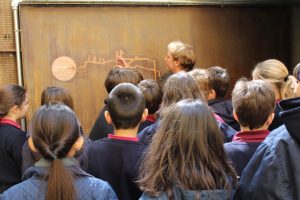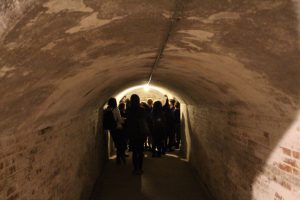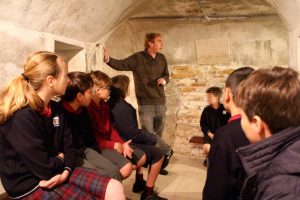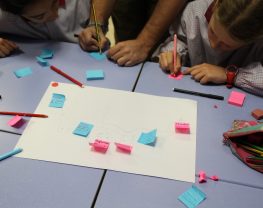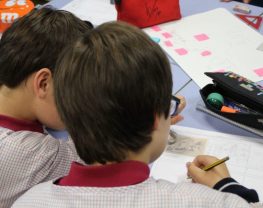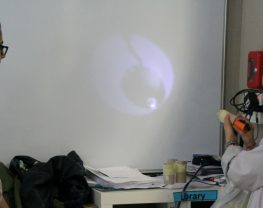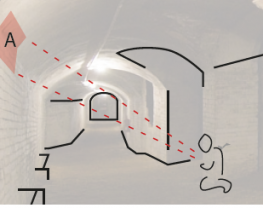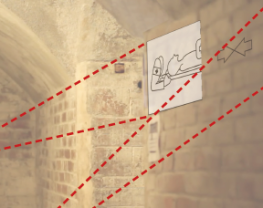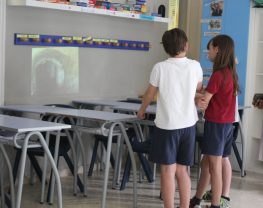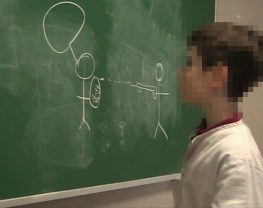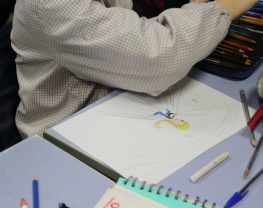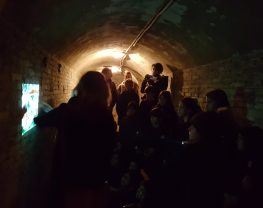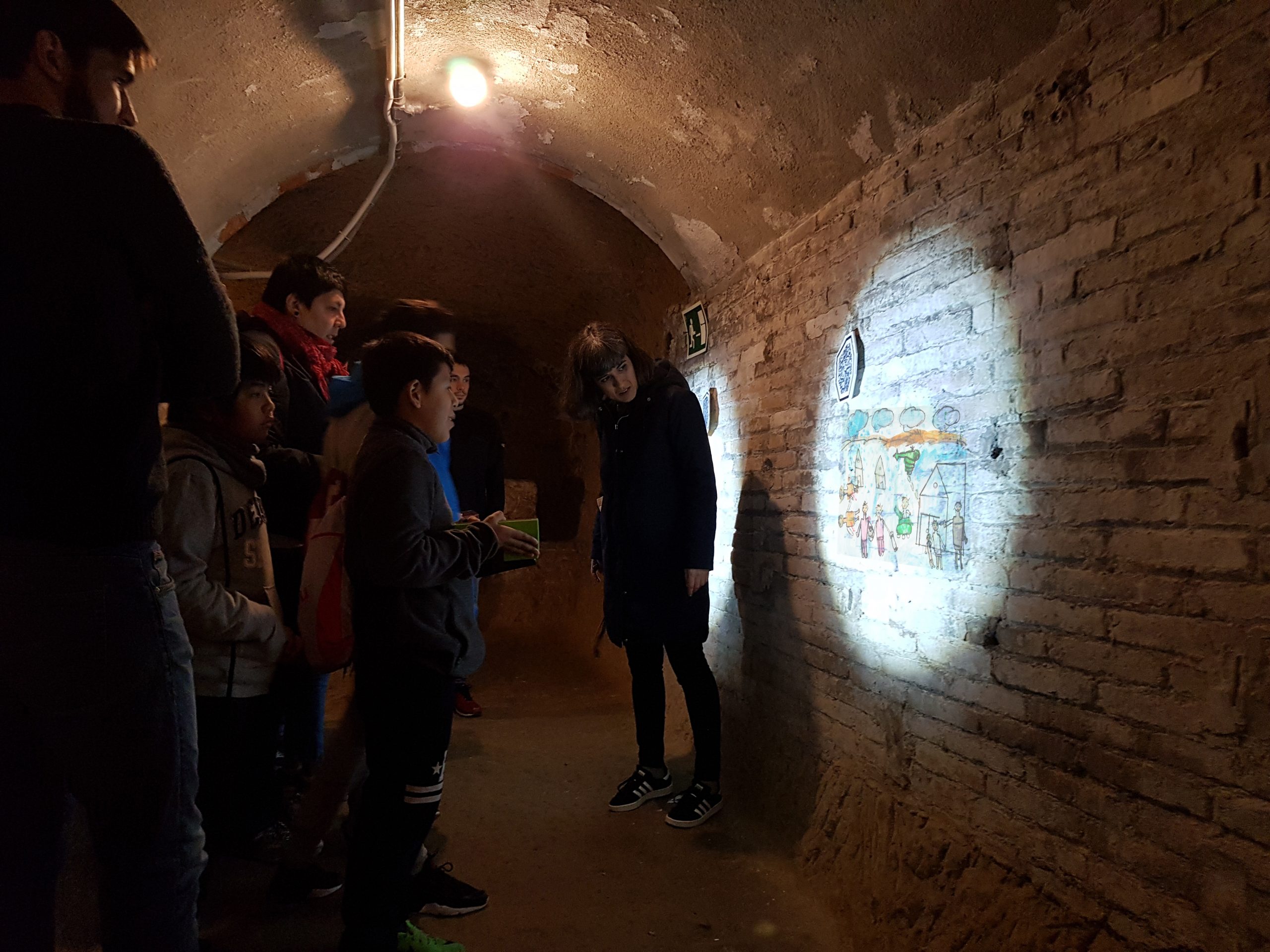
Within the context of the research project Evaluation-Driven Design (Grant TIN2014-60599-P), I collaborated with the Barcelona History Museum (MUHBA) in the design of an educational Virtual Heritage experience for the Spanish Civil War shelter Refugi 307. The main goal of the collaboration was to identify opportunities to complement the educational experience of the traditional guided visit in the shelter through technology-enhanced learning strategies. Our design approach was based on contextual inquiry, co-design and iterative evaluation studies of the user experience with curators, museum educators, visit guides, students (10 to 12 years old) and teachers from two local primary schools.
In the project, we explored the potential of a novel and emerging conceptual paradigm to design ARMR applications for mobile technologies: the World-as-Support (WaS) interaction paradigm. This paradigm is based on projective augmented reality configurations which allow the users to augment the physical surroundings by intelligently projecting the digital information on the physical world. In this project, we used the conceptual paradigm as metaphor for Magical Lanterns to reveal additional experiential layers of the educational context.
Design process and research methods
Our research team first analysed the requirements for this project through a contextual inquiry study of the guided visit and consecutive co-design workshops in school with a total of 40 children. We validated then two design iterations of the system through experimental evaluation with a total of 52 children. Our results showed that the educational experience offered opportunities to enhance students’ understanding of the historical context. Specifically, it fostered students’ comprehension of socio-cultural values related to the Spanish Civil war such as human dignity, solidarity and pluralism.
The research methods used during the design process are described below. For more details about the results check the related publications (end of this post) or contact me on LinkedIn.
1) Contextual inquiry – How do the students experience the existing guided visit?
- Interviews with teachers, curators and museum educators to define the educational goals
- Open-ended questionnaires with students to research their understandings around the educational context
- Observations of students’ behaviour during the traditional guided visit
- Dwelling Space Technique to research children’s worldviews in relation to the educational context and observe how the children become bodily engaged with the physical space
- The guide showed the map of the different tunnels that connect the shelter.
- The shelter is an empty and humid space which does not permit any alterations on the walls.
- The shelter allows to embody actions from civilians that experienced the shelter, e.g. sitting on benches during the bomb attack.
2) Co-Design – Which aspects would the stakeholders improve of the guided visit?
- Focus groups with teachers, curators and museum educators to define ideas for new educational activities in the shelter based on technology-enhanced learning strategies
- Co-Design workshops with students to elicit their interests and ideas for the Virtual Heritage experience
- Low-tech prototyping and bodystorming of design proposals
- The children drew how they remembered the map of the physical space and highlighted locations of their interest.
- The students created storyboards of narratives related to the Spanish Civil War for the guided visit.
- The children bodystormed their ideas with a low-tech prototype.
3) Ideation and Prototyping
- Awareness of the environment may be fostered through projections on surfaces and objects to represent missing content at their original locations; e.g. the signs describing shelter behaviour rules can be projected on areas of the walls that are now empty.
- Users can be made aware of historical events of the local context by projecting situated audiovisual content; e.g. by triggering, close to pickaxe marks on a wall, testimonials of civilians who constructed the shelter.
- The system can split content between multiple users, each having a WaS device, and foster movement-based collaborative activities; e.g. two users project each a different half of an object that needs to be recomposed through their collaboration.
- High-fidelity prototyping with marker recognition system
- Digital augmentation of missing objects in the shelter
- Collaborative learning activities
- Prototyping the Virtual Heritage experience with the students
4) Evaluation and User Experience Testing
- Triangulation of qualitative and quantitative data based on questionnaires, individual interviews, drawings and multimodal analysis of in-situ interactions
- Pictionary Technique to understand students’ learning gains
- Reflective Drawing Technique to understand student’s user experience from a retroperspective
- Understand student’s learning gains
- Retroperspective analysis of students’ user experience
- Multimodal Analysis of in-situ interactions
Related Publications:
Marie-Monique Schaper and Narcis Pares. (2022). Enhancing Students’ Social and Emotional Learning in Educational Virtual Heritage through Projective Augmented Reality. In CHI EA ’22: CHI Conference on Human Factors in Computing Systems Extended Abstracts, Article No.: 18, Pages 1–9. https://doi.org/10.1145/3491101.3503551
Marie-Monique Schaper, Ole Sejer Iversen, Laura Malinverni, and Narcis Pares. (2019). FUBImethod: Strategies to engage children in the co-design of Full-Body interactive experiences. International Journal of Human-Computer Studies, 132: 52-69. https://doi.org/10.1016/j.ijhcs.2019.07.008
Marie-Monique Schaper, Maria Santos, and Narcis Pares. (2018). Orchestrating experts’ assumptions and children’s values in the design of Virtual Heritage experiences. International Journal of Child-Computer Interaction. DOI=https://doi.org/10.1016/j.ijcci.2018.02.001
Marie-Monique Schaper, Maria Santos, Laura Malinverni, Juan Zerbini Berro and Narcis Pares. (2018). Learning about the past through situatedness, embodied exploration and digital augmentation of cultural heritage sites. International Journal of Human-Computer Studies. DOI=http://dx.doi.org/10.1016/j.ijhcs.2018.01.003
Marie-Monique Schaper, Maria Santos, Laura Malinverni and Narcis Pares. (2017).
Co-Designing Virtual Heritage Experiences for Archaeological Sites based on the novel AR Paradigm World-as-Support. ACM Celebration of Women in Computing, WomENCourage Conference 2017. See conference abstract
Maria Santos, Marie-Monique Schaper, and Narcis Pares. (2017). Moving through the past: design and evaluation of a full-body interaction learning environment for a public space. In Proceedings of the XVIII International Conference on Human Computer Interaction (Interacción ’17). ACM, New York, NY, USA, Article 54, 3 pages. DOI: https://doi.org/10.1145/3123818.3133833
Marie-Monique Schaper, Maria Santos, Laura Malinverni and Narcis Pares. (2017). Towards the Design of a Virtual Heritage Experience based on the World-as-Support Interaction Paradigm. In Proceedings of the 2017 CHI Conference Extended Abstracts on Human Factors in Computing Systems (CHI EA ’17). DOI=http://dx.doi.org/10.1145/3027063.3053089
